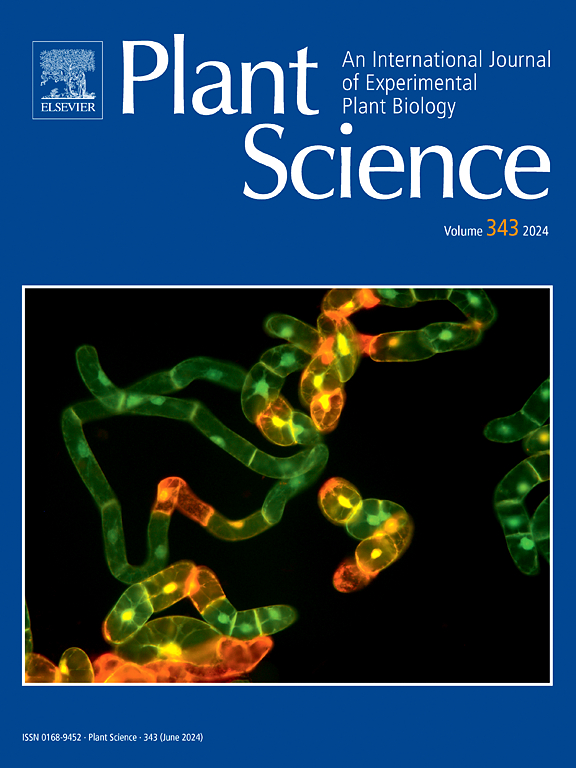Comprehensive metabolomics and transcriptomics analysis reveal the regulatory mechanism of StHY5 on anthocyanin accumulation in potato tubers
IF 4.2
2区 生物学
Q2 BIOCHEMISTRY & MOLECULAR BIOLOGY
引用次数: 0
Abstract
Light is a key factor for inducing anthocyanin biosynthesis; however, its regulatory mode in potato anthocyanin biosynthesis remains unclear. Previous research identified a specific genotype that causes the tuber skin to gradually turn purple when exposed to light of different wavelengths. In the present study, we conducted metabolome and transcriptome analyses on tuber samples during anthocyanin accumulation. The metabolome data showed that the contents of naringenin chalcone, naringenin, dihydrokaempferol, and cyanidin gradually increased during anthocyanin accumulation. The transcriptome data showed that the expression levels of most structural genes increased gradually during anthocyanin accumulation, especially the StF3’H gene that promotes cyanidin formation. Moreover, the photo-responsive transcription factor StHY5 was specifically expressed at high levels before anthocyanin accumulation, occurring 2 h after light induction. Establishment of transgenic lines demonstrated that StHY5 overexpression could promote the accumulation of anthocyanin in potato tubers, along with a parallel increase in the transcription levels of StAN2, StMYBA1, StCHI, StF3H, StF3’H, and StDFR. Electrophoretic mobility shift and dual luciferase assays showed that StHY5 can enhance the promoter activity of the MYB transcription factors StAN2 and StMYBA1 as well as the structural genes StCHI and StF3H through binding to the G-box motif. StAN2 activated the expression of StF3’H (a newly identified purple gene locus in potato) and StDFR by binding to the MYB-binding site in the promoters, thereby promoting anthocyanin biosynthesis. This study provides a theoretical basis for revealing the molecular mechanism of light-regulated anthocyanin biosynthesis in potatoes.
综合代谢组学和转录组学分析揭示了StHY5对马铃薯块茎花青素积累的调控机制
光是诱导花青素生物合成的关键因素;然而,其在马铃薯花青素生物合成中的调控模式尚不清楚。先前的研究发现了一种特殊的基因型,当暴露在不同波长的光下时,这种基因型会导致块茎皮肤逐渐变成紫色。在本研究中,我们对块茎样品进行了花青素积累过程中的代谢组和转录组分析。代谢组学数据表明,在花青素积累过程中,柚皮素查尔酮、柚皮素、二氢山奈酚和花青素的含量逐渐增加。转录组数据显示,在花青素积累过程中,大多数结构基因的表达水平逐渐升高,尤其是促进花青素形成的StF3'H基因。此外,光响应转录因子sty5在花青素积累前特异性高水平表达,发生在光诱导后2 h。转基因株系的建立表明,过表达sty5可以促进马铃薯块茎花青素的积累,同时StAN2、StMYBA1、StCHI、StF3H、stf3’h和StDFR的转录水平平行增加。电泳迁移位移和双荧光素酶实验表明,sty5通过与G-box基序结合,可以增强MYB转录因子StAN2和StMYBA1以及结构基因StCHI和StF3H的启动子活性。StAN2通过结合启动子中的myb结合位点,激活StF3'H(马铃薯中新发现的紫色基因位点)和StDFR的表达,从而促进花青素的生物合成。本研究为揭示马铃薯光调控花青素生物合成的分子机制提供了理论基础。
本文章由计算机程序翻译,如有差异,请以英文原文为准。
求助全文
约1分钟内获得全文
求助全文
来源期刊

Plant Science
生物-生化与分子生物学
CiteScore
9.10
自引率
1.90%
发文量
322
审稿时长
33 days
期刊介绍:
Plant Science will publish in the minimum of time, research manuscripts as well as commissioned reviews and commentaries recommended by its referees in all areas of experimental plant biology with emphasis in the broad areas of genomics, proteomics, biochemistry (including enzymology), physiology, cell biology, development, genetics, functional plant breeding, systems biology and the interaction of plants with the environment.
Manuscripts for full consideration should be written concisely and essentially as a final report. The main criterion for publication is that the manuscript must contain original and significant insights that lead to a better understanding of fundamental plant biology. Papers centering on plant cell culture should be of interest to a wide audience and methods employed result in a substantial improvement over existing established techniques and approaches. Methods papers are welcome only when the technique(s) described is novel or provides a major advancement of established protocols.
 求助内容:
求助内容: 应助结果提醒方式:
应助结果提醒方式:


